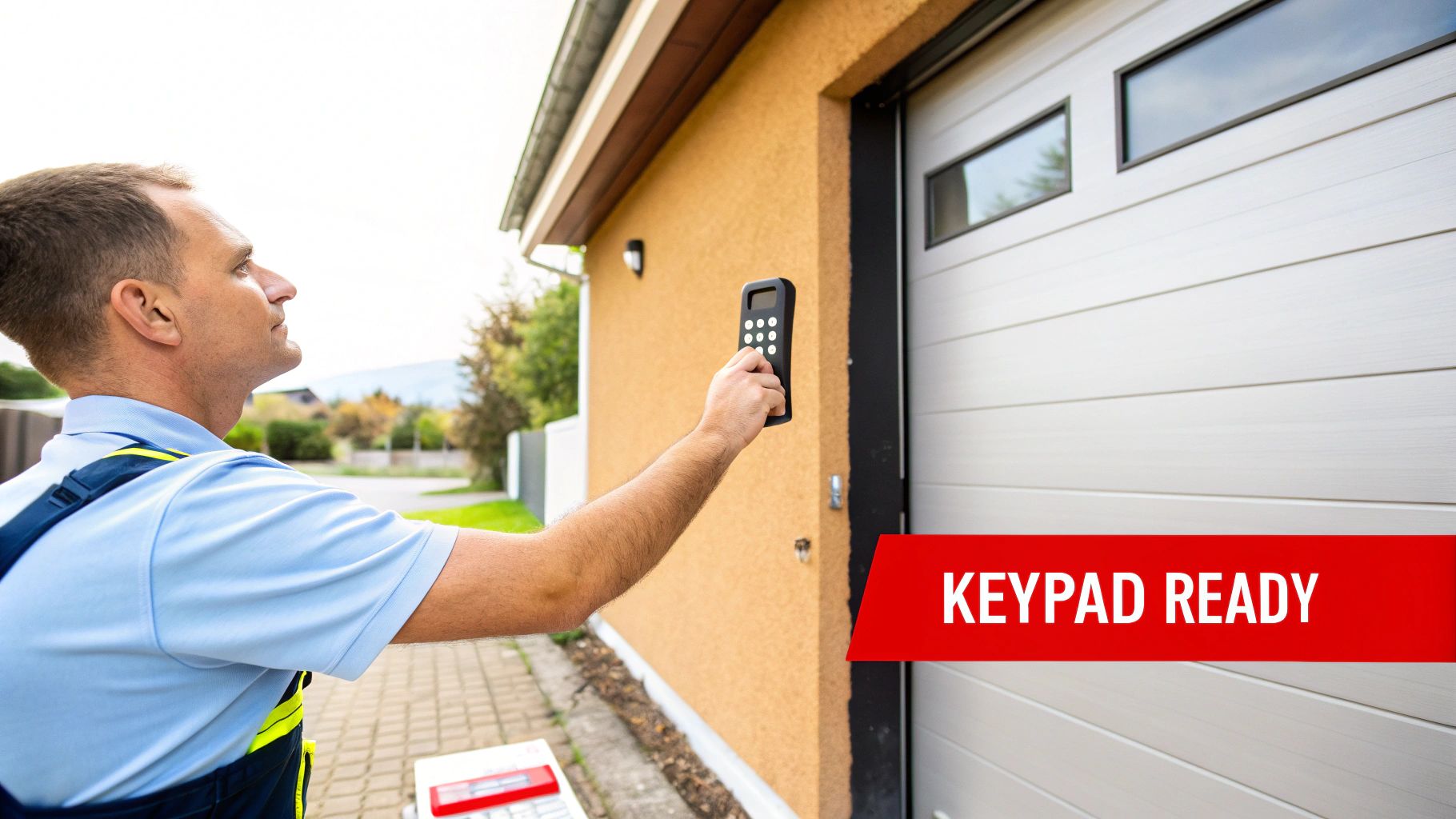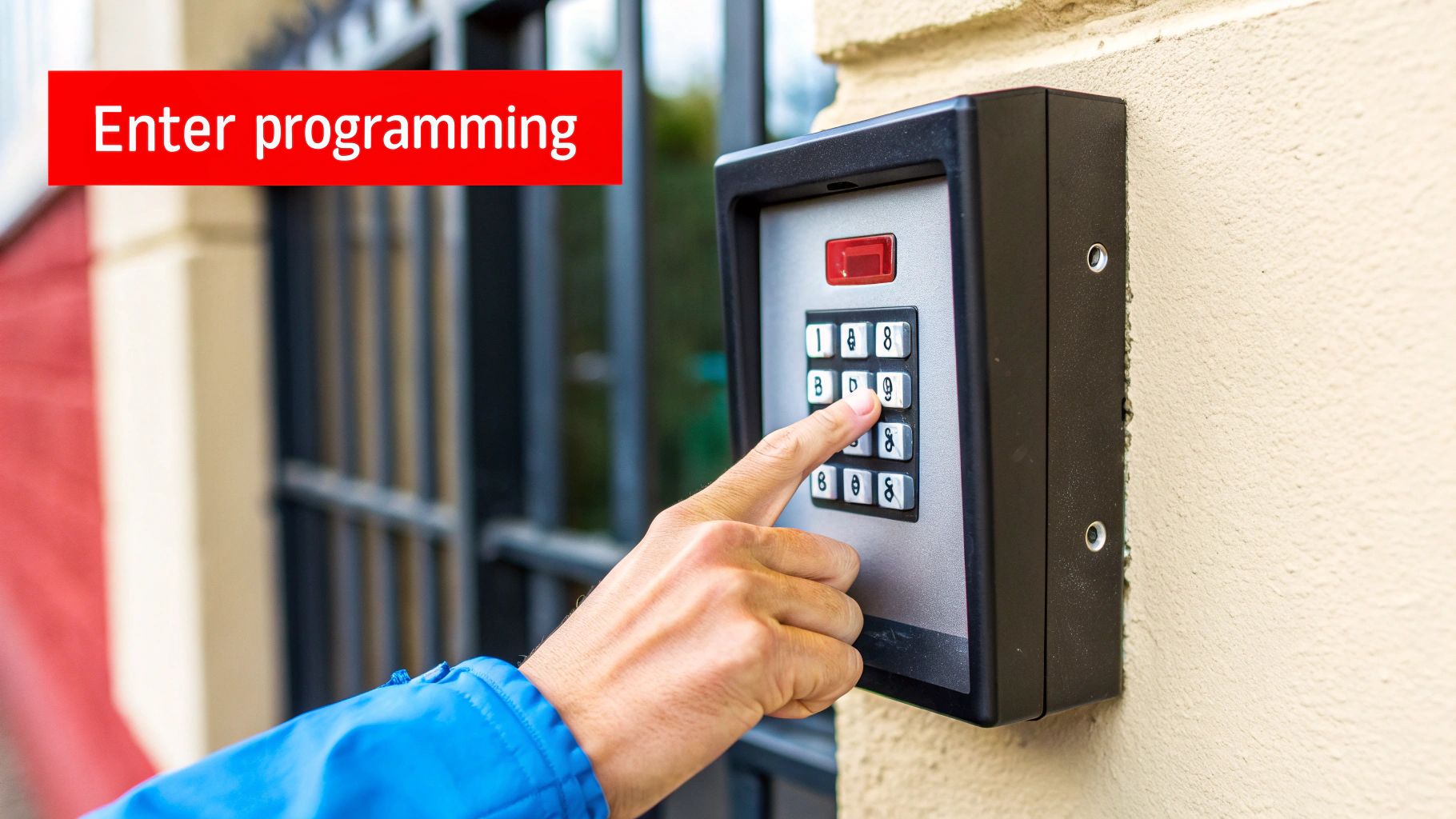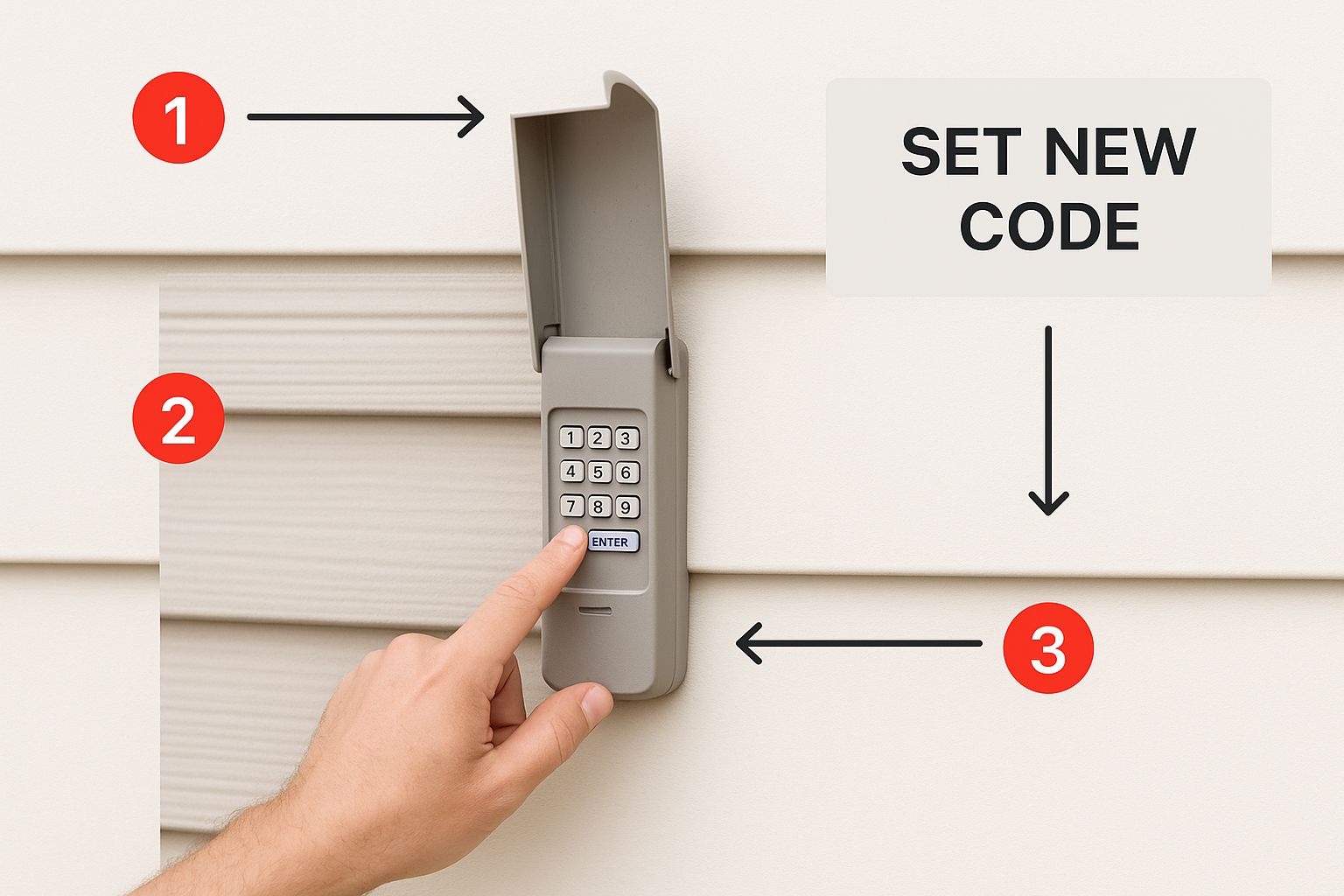Programming your overhead door keypad might seem like a job for a pro, but it's usually a quick DIY task that provides a significant boost to your property's security and convenience. For homeowners and business operators across Texas and Oklahoma, mastering this process is a critical step in managing property access.
The core process is straightforward: locate the 'Learn' button on your garage door opener motor, press it to activate pairing mode, and then enter your chosen PIN on the keypad. This simple sequence syncs the two devices, establishing a new secure access code. Knowing how to do this is a game-changer for controlling who comes and goes—be it family, employees, or delivery drivers.
Why Bother With Keypad Programming? It's All About Control
Properly programming your overhead door keypad is more than a convenience; it’s a fundamental layer of modern security. Whether you're a homeowner in a busy Dallas suburb or managing a commercial facility in Oklahoma City, controlling access is paramount. Using a default code or a compromised PIN is a significant security risk. Regularly changing your keypad code puts you firmly in control.
Taking a few minutes to update your code delivers measurable benefits:
- Tighter Security: Immediately revokes access for anyone with an old or compromised code.
- Smoother Operations: For businesses, it eliminates the need for physical keys, reducing issues with lost keys and improving workflow for staff and deliveries.
- Total Peace of Mind: Knowing your property is secure, whether you're on-site or miles away, is invaluable.
The demand for enhanced property security isn't just anecdotal; it's a powerful market trend. The global door security keypad market has grown into a multi-billion dollar industry, with an estimated 150 million units shipped annually. This growth is a direct response to a rising need for reliable, user-managed security at both homes and businesses.
Before we dive into the specific steps, here’s a quick overview of the process.
Keypad Programming At a Glance
| Phase | Requirement | Key Action |
|---|---|---|
| Preparation | Physical access to the garage door opener motor | Locate the 'Learn' or 'Program' button |
| Synchronization | A new, memorable PIN (4-6 digits) | Press the 'Learn' button and enter the new PIN on the keypad |
| Confirmation | Observe the opener's light and keypad feedback | Wait for the opener light to blink or the keypad to confirm |
| Testing | Ensure the new PIN works correctly | Enter the PIN and press the 'Enter' or 'Open' key to test |
Getting the programming right ensures your system works every time, a non-negotiable for properties facing the unpredictable weather patterns common in Texas and Oklahoma.
If you’re curious about the mechanics behind this and want to expand your DIY skills, this comprehensive guide on programming various keys is a great resource for understanding the core concepts.

Preparing for a Smooth Programming Process

Before you touch a single button, a little prep work can be the difference between a five-minute job and a frustrating afternoon. When it comes to programming an overhead door keypad, getting the basics sorted out first is the secret to a quick, successful sync.
It’s easy to see why this matters. The global market for overhead doors is projected to reach $5.4 billion by 2025, with North America leading demand. That’s a massive number of keypads that need to function correctly for homes and businesses. You can explore the data yourself in this market report.
Pre-Programming Checklist
First, you need to locate the "Learn" or "Program" button on your garage door opener motor. It's typically a small, square button on the motor unit mounted to your ceiling, sometimes brightly colored for visibility. Common brands like LiftMaster, Genie, or Chamberlain all use a similar system.
Pro Tip: In Texas and Oklahoma, dust, dirt, and even spider webs can obscure this small but critical button. We recommend using a flashlight and a dry cloth to wipe down the motor housing. This makes the button easier to find and helps ensure it doesn’t stick when pressed.
Next, focus on the keypad itself. A weak battery is the culprit behind a surprising number of service calls, as it may not have enough power to send a strong, consistent signal to the opener. Always start with a fresh battery.
Finally, conduct a quick safety scan of the area:
- Ensure nothing is obstructing the door's path.
- Check that the safety sensors near the floor are aligned and their lenses are clean.
Misaligned sensors can interrupt the programming process as a safety precaution. Our guide explains why functional overhead garage door sensors are so critical for safe operation. Completing this simple checklist will set you up for a much smoother experience.
Programming Your Residential and Commercial Keypads
With the preparation handled, you're ready to program your keypad. The good news is that most major brands follow a similar programming logic. The process involves a clear sequence of button presses that "teaches" the keypad and the opener motor to communicate, giving you secure and reliable access.
The workflow consists of four main actions: clearing old codes (optional but recommended), putting the opener into "Learn" mode, entering your new PIN, and confirming the connection.
This simple workflow gives you a great visual of how to set your new PIN.

As the image shows, that final step is where your input syncs the keypad to the opener, locking in your new secure code.
Executing the Programming Sequence
First, press and hold the program button on the keypad until the LED light starts to blink. This indicates it’s ready to receive a new code.
Next, go to your garage door opener motor unit and press the "Learn" button once. This is the crucial step that opens the communication channel. You typically have about 30 seconds to return to the keypad and enter your PIN before the opener times out.
Quickly type your new 4-6 digit PIN into the keypad, then press the "Enter" or "Open/Close" button. The main light on the opener should flash, or you may hear an audible click. This is your confirmation that the code has been accepted. Test it immediately by entering the new PIN to ensure the door operates correctly.
Real-World Scenarios in Texas and Oklahoma
The application of this feature varies significantly. A homeowner in Dallas might program a single code for family use. In contrast, a warehouse manager in Oklahoma City may need to manage multiple keypads and regularly add or delete codes for new employees, shift changes, and delivery personnel.
One of the most valuable features for both residential and commercial users is the ability to set temporary PINs.
For example, if you have a contractor coming to your Abilene home for a week-long project, you can program a temporary code and delete it once the job is complete. This smart security practice keeps your primary code confidential and maintains full control over access.
Safety First: Before testing a new code, always perform a visual scan to ensure the door's path is completely clear of people, pets, vehicles, and objects. While the UL 325 safety standard mandates that modern openers have reversing mechanisms, a clear path is the best first defense against accidents.
For businesses, managing temporary codes is critical for handling staff turnover or multiple vendors. For more advanced solutions, our expertise with commercial door access control systems can help streamline this process, preventing unauthorized entry and keeping your operations secure.
Troubleshooting Common Programming Headaches
Even with perfect execution, technology can be temperamental. If your overhead door keypad programming hits a snag, don't worry. The issue is usually one of a few common culprits, and knowing what to look for can turn frustration into a quick fix.
Common symptoms include a keypad that blinks but won't activate the door, or a code that works intermittently. These often point to a simple explanation. For instance, signal interference from Wi-Fi routers, smart home devices, and even certain LED light bulbs can disrupt communication between the keypad and the opener.
Diagnosing the Problem
Before assuming a major failure, start with the basics. It's surprising how often keypad issues, especially in the Texas and Oklahoma heat, come down to a weak battery. High temperatures can reduce a battery’s lifespan by up to 20% compared to milder climates. Installing a fresh battery should always be your first step.
Another common roadblock is incompatibility. If you've just installed a new keypad, confirm it's designed for your specific garage door opener model. A "universal" keypad may not be compatible with an opener that uses a different security protocol, like rolling code technology.
Key Takeaway: An unreliable keypad rarely indicates a broken opener. More often, it's an external factor like signal interference, a battery drained by extreme weather, or dirty connection points that you can fix without a service call.
Common Issues and Their Solutions
If a new battery doesn't solve the problem, it's time to dig deeper. Here are some of the most frequent issues we see and how to resolve them:
-
The keypad blinks, but the door stays put. This classic symptom means the keypad is sending a signal, but the opener isn't receiving or accepting it. The connection has likely been lost. The best solution is to clear the opener motor's memory of all remotes and keypads, then reprogram your keypad from scratch.
-
The "Learn" button does nothing. If pressing the "Learn" button on the opener yields no response from the indicator light, you could be facing an issue with the opener's logic board. This is a good time to review common problems with garage door openers to determine if you need professional service.
-
The code only works when you're standing right next to the door. This is a textbook sign of a weak signal. Start by changing the battery. If that doesn't fix it, the problem is likely interference. Try temporarily unplugging nearby wireless devices to see if the keypad's range improves.
While we're focused on garage doors, the troubleshooting principles for electronic keys are often similar across different devices. For a broader look at these concepts, a practical problem-solving guide for programming electronic keys offers some great insights that can be surprisingly helpful.
Common Programming Problems and Solutions
When you're troubleshooting, a quick-reference guide is invaluable. This table helps you rapidly diagnose the issue and determine your next step.
| Symptom | Potential Cause | Recommended Solution |
|---|---|---|
| No response from keypad | Dead battery; Out of range; Keypad not programmed. | Replace the battery; Move closer to the motor unit; Reprogram the keypad. |
| Blinking light but no door movement | Opener memory is full; Lost sync with opener; Safety sensors are blocked. | Clear the opener's memory and reprogram; Check and clear sensor obstructions. |
| Code works intermittently | Weak battery; Signal interference; Corroded battery contacts. | Replace the battery; Identify and move sources of RF interference; Clean contacts. |
| Can't enter a new PIN | Incorrect programming sequence; Old PIN still active. | Consult the manual to restart the process; Perform a full memory wipe. |
Think of this table as your first line of defense. Most of the time, the solution is right here and doesn't require any special tools—just a little patience.
Beyond the Basics: Advanced Security and Maintenance
Getting your overhead door keypad programmed is just the first step. To ensure long-term reliability and security, proactive management and maintenance are essential, especially given the harsh weather conditions in Texas and Oklahoma.
Strong security habits are your first line of defense. Avoid easily guessable codes like '1234' or your street address. Always choose a random, non-sequential number that has no personal significance. For a business, it is best practice to rotate your primary access PIN every 30 to 90 days as a standard security protocol.
Proactive Management for Long-Term Security
If you run a business with frequent visitors, temporary codes are your most powerful tool. Grant a vendor or contractor a code that is only valid for the duration of their work, then immediately delete it upon completion. This practice keeps your primary codes secure. Many businesses find that upgrading to more sophisticated commercial door access control systems is a worthy investment for streamlining this process.
A Pro's Tip: The intense UV exposure in Texas and Oklahoma can degrade plastic keypad covers, making them brittle and faded. Applying a UV-protectant cleaner a few times a year can significantly extend the life of the keypad housing and prevent cracks.
Seasonal storms present another challenge. Before the spring and fall storm seasons, inspect the rubber seals and casing on your keypad. Even a tiny crack can allow moisture intrusion during a downpour, leading to corrosion and keypad failure.
Here’s a simple maintenance checklist for our local clients:
- Every Few Months: Gently wipe the keypad with a damp cloth to remove dust and grime that can make buttons sticky.
- Twice a Year: Apply a UV-protectant spray to the plastic housing to prevent sun damage.
- Before Storm Season: Inspect weather-stripping and seals for any signs of cracking or wear and replace them to prevent water damage.
Your Top Questions About Keypad Programming Answered
We regularly field questions from homeowners and businesses across Texas and Oklahoma about their garage door keypads. Here are straightforward answers to the most common inquiries we receive.
How Often Should I Change My Garage Door Keypad Code?
This is an excellent question. For residential properties, we recommend changing the code every 6-12 months as a smart security practice.
For commercial properties in cities like Denison or Abilene, the standard is much stricter. Any time you grant temporary access to a contractor or service provider, the code should be changed immediately after their work is completed. Treating every temporary code as a potential liability is the safest approach.
Can I Just Buy a Universal Keypad for My Garage Door?
While it seems simple, it’s not always a guaranteed solution. Many "universal" keypads claim compatibility with major brands like LiftMaster or Genie, but this isn't always the case. Incompatibility is a frequent cause of programming failure.
Before purchasing, verify two key details:
- Does the keypad support your opener’s specific radio frequency and security technology (e.g., rolling code)?
- Is it compatible with the manufacturing year of your opener?
This due diligence can save you a significant amount of time and frustration.
Why Is My Keypad Blinking but the Door Isn't Budging?
The classic blinking light is a good sign—it means the keypad has power and is attempting to transmit a signal. The problem is that the opener is not receiving or acting on it.
This issue typically stems from a few sources: a mistyped PIN, signal interference from other electronics, or the keypad has lost its synchronization with the opener. First, try re-entering your code slowly and deliberately. If that fails, the most effective solution is to wipe the opener's memory and reprogram the keypad from scratch.
Does the Crazy Texas Weather Mess With My Keypad?
Absolutely. The intense summer heat can drain batteries faster than expected. Conversely, heavy spring storms can allow moisture to penetrate a keypad with aging or cracked seals.
We advise checking your batteries more frequently during hot months and inspecting the keypad housing for any damage after a major storm. A little preventative maintenance goes a long way in ensuring your keypad remains weatherproof and functions reliably.
Your overhead door is a critical component of your property’s security and daily operation. Whether you need routine maintenance, a complex repair, or a complete installation, Overhead Door Co. of Tex-Oma has the hands-on experience to get the job done right.
